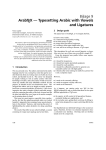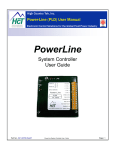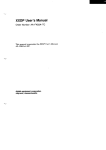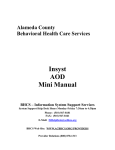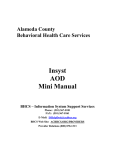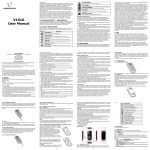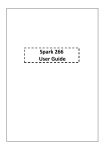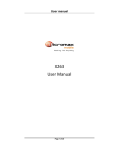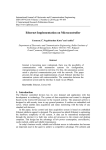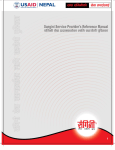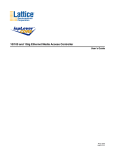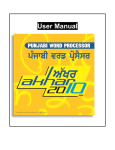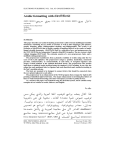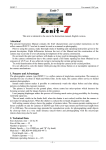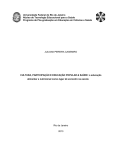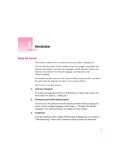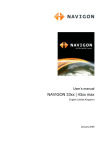Download Macintosh Arabic Language Kit Installation and User`s
Transcript
Macintosh Arabic Language Kit Installation and User’s Manual Manuel d’installation et d’utilisation K Apple Computer, Inc. This manual and the software described in it are copyrighted by Apple, with all rights reserved. Under the copyright laws, this manual or the software may not be copied, in whole or in part, without the written consent of Apple, except in the normal use of the software or to make a backup copy of the software. The same proprietary and copyright notices must be affixed to any permitted copies as were affixed to the original. This exception does not allow copies to be made for others, whether or not sold, but all of the material purchased (with all backup copies) may be sold, given, or loaned to another person. Under the law, copying includes translating into another language or format. You may use the software on any computer owned by you, but extra copies cannot be made for this purpose. The Apple logo is a trademark of Apple Computer, Inc., registered in the U.S. and other countries. Use of the “keyboard” Apple logo (Option-Shift-K) for commercial purposes without the prior written consent of Apple may constitute trademark infringement and unfair competition in violation of federal and state laws. Every effort has been made to ensure that the information in this manual is accurate. Apple is not responsible for printing or clerical errors. © 1995 Apple Computer, Inc. 1 Infinite Loop Cupertino, CA 95014-2084 (408) 996-1010 Apple, the Apple logo, Macintosh, Power Macintosh, and QuickDraw are trademarks of Apple Computer, Inc., registered in the U.S. and other countries. TrueType and WorldScript are trademarks of Apple Computer, Inc. Adobe and PostScript are trademarks of Adobe Systems Incorporated, which may be registered in certain jurisdictions. Times is a registered trademark of Linotype-Hell AG and/or its subsidiaries. Simultaneously published in the United States and Canada. Mention of third-party products is for informational purposes only and constitutes neither an endorsement nor a recommendation. Apple assumes no responsibility with regard to the performance or use of these products. Contents Chapter 1 Introduction A-1 About this manual A-1 About the Arabic Language Kit A-1 Requirements A-2 Chapter 2 Setting Up A-3 Installing the Arabic Language Kit from the compact disc A-3 Installing the Arabic Language Kit from floppy disks A-3 Displaying Arabic or Persian filenames correctly A-5 Installing SimpleText Arabic A-6 Removing the Arabic Language Kit from your system A-6 Chapter 3 Choosing a Language for Your Application Program A-9 The Arabic Language Register program A-9 Registering your program for Arabic A-9 Creating a Roman Language Register A-10 Chapter 4 Working in Multiple Languages A-11 What are scripts? A-11 Primary and secondary scripts A-12 Choosing a keyboard layout A-12 Arabic Language Kit keyboard layouts A-12 The standard Arabic keyboard layout A-13 Arabic keyboard layout for PowerBook computers A-13 The Arabic-QWERTY transliterated keyboard layout A-14 The Arabe-AZERTY transliterated keyboard layout A-15 The Persian keyboard layout A-16 About the transliterated keyboard layouts A-16 Transliteration guidelines A-16 The Keyboard control panel A-18 The Text control panel A-18 Specific features for right-to-left scripts A-19 The Arabic Setting control panel A-19 The Persian Setting control panel A-21 The Arabic characters encoding table A-21 Chapter 5 Troubleshooting A-23 A-iii Chapter 1 Introduction About this manual This manual explains how to install your Arabic Language Kit. You will also learn how to designate which of your application programs should be opened in Arabic, and how to use the control panels and menus that the language kit adds to your system software. Chapter 3 of this manual to designate either Arabic or Persian as the language for your Arabic-script program. 4. To find out more about the Arabic language support you have installed, read Chapter 4 of this manual. Chapter 4 explains how to use the new Keyboards menu, and how to set your Text, Keyboard, and Arabic/Persian Setting control panels to customize your computer’s Arabic-script capabilities. It also displays the keyboard layouts provided with the language kit. Here is how to use this manual: 1. Decide which parts of the Arabic Language Kit you want to install. You can install Arabic and Persian. Follow the instructions in Chapter 2 of this manual to install Arabic or Persian. 2. Display Arabic file and folder names correctly. Follow the instructions in Chapter 2 of this manual to adjust the Views control panel so that you can read Arabic filenames. 3. Display Arabic menus correctly in your Arabic application programs. Most Arabic application programs display Arabic correctly after you install the Arabic Language Kit. Follow the instructions in About the Arabic Language Kit The Arabic Language Kit contains all the software you need to work in Arabic or Persian on your computer. You can use your computer’s Arabic-script capabilities in two ways: m If you have a Macintosh application program that has been localized for use in Arabic, the menus, dialog boxes, help messages, and other elements will be displayed in Arabic. m You can enter English, Arabic, and Persian in a single document, using any Arabic or non-Arabic application program that takes advantage of WorldScript I. (Check with the program’s manufacturer if you’re not sure your program is fully compatible with WorldScript I.) A-1 NOIR/PANTONE 1 1 The Arabic Language Kit includes: m The Arabic Language Register, a program that lets you specify which of your application programs should be opened in Arabic. Programs registered for Arabic will display menus and dialog boxes in Arabic. m WorldScript I, an extension to system software version 7.1 or later that enables your system to handle languages like Arabic, which are written from right to left. m System software resources needed for Arabic and Persian. m Seven Arabic fonts in a variety of formats, including: AlBayan (TrueType, PostScript) Baghdad (TrueType, PostScript) Geeza (TrueType, PostScript) m A choice of keyboard layouts including standard Arabic and Persian layouts, as well as phonetically transcribed keyboard layouts for the standard QWERTY (English) and AZERTY (French) keyboard layouts. m A set of key caps labels with Arabic characters to stick on your keyboard. m A set of key caps labels with Persian characters to stick on your keyboard. m SimpleText Arabic. Requirements The Arabic Language Kit runs on any Macintosh computer equipped with the following: Kufi (TrueType, PostScript) m Macintosh system software version 7.1 or later. Nadeem (TrueType, PostScript) m At least 4 megabytes of RAM (8 megabytes if you are using Macintosh System 7.5 with QuickDraw GX installed). Thuluth (PostScript, bitmap) Cairo (bitmap) m Six Persian fonts in a variety of formats, including: Amir (PostScript, TrueType) Asfahan (PostScript, TrueType) Mashad (PostScript, TrueType) NadeemFarsi (PostScript, TrueType) Kamran (TrueType) Tehran (bitmap) A-2 Chapter 1: Introduction NOIR/PANTONE 2 2 On a Power Macintosh at least 8 megabytes of RAM (16 megabytes if you are using System 7.5 and QuickDraw GX). m An internal or external hard disk drive. m A floppy disk drive capable of reading high-density (1.4-megabyte) floppy disks, or a CD-ROM drive. Chapter 2 Setting Up Before you can use the Arabic Language Kit you must install the software. You may also want to consider setting your Views control panel to display Arabic file and folder names correctly on your screen. Installing the Arabic Language Kit from the compact disc If your computer has a CD-ROM drive, you can install the Arabic Language Kit from the Macintosh Arabic Language Kit CD disc that came with your kit. To use the CD-ROM for installation, follow the instructions in the next section of this manual, “Installing the Arabic Language Kit from Floppy Disks.” The procedure is the same, but you won’t have to swap disks. Everything you need is contained on the CD-ROM disc. Installing the Arabic Language Kit from floppy disks The installation process automatically makes a backup copy of your System Folder (to protect the contents during installation of the Arabic Language Kit). The backup copy uses approximately 3␣ megabytes of space on your hard disk. This space is made available to you again after installation is completed. Your Arabic Language Kit includes five installation disks. You will need four of these disks for English installation: Install 1, English and Install 2, 3, and 4. Have these disks ready before you begin. The Installer provides you with three installation choices: m Arabic installation (includes the Arabic keyboard layout, the Arabic-QWERTY keyboard, and five Arabic TrueType fonts). m Persian installation (includes the Persian keyboard layout, and five Persian TrueType fonts). m Optional items (includes Arabic and Persian PostScript fonts, and additional keyboard layout choices). v Note: To find out more about the keyboard layouts included in your Arabic Language Kit, read Chapter 4 of this manual. v Unless you’ve already installed Arabic or Persian, you should select at least one of these choices. You can choose as many of the optional customized installation items as you want. 1. Quit any open application programs. If you have any virus-detection software, turn it off. A-3 NOIR/PANTONE 3 3 v Note: It’s best to start your computer with all extensions turned off before doing the installation. To do so, hold the Shift key down while your computer is starting. v 2. Insert the Install 1, English disk into your floppy drive (or insert the Macintosh Arabic Language Kit CD disc into your CD-ROM drive). Click the checkbox of each item you want to install. You should see the Installer icon in the Install 1, English disk’s window. 3. Open the Installer by double-clicking its icon. Make sure this is the name of the disk where you want to install the language kit. Click here to switch to a different disk for installation. Click here to install the Arabic Language Kit. After a few moments, you see a welcome screen. 4. Click Continue. The Custom Install dialog box appears. 5. Make sure that the hard disk named is the one where you want to install Arabic or Persian. If a different disk name appears, click the Switch Disk button until you see the name of the correct disk. 6. Click the items you want to install to select them. 7. Click Install. Messages tell you when you need to insert another disk. It takes a few minutes to complete the installation. A-4 Chapter 2: Setting Up NOIR/PANTONE 4 4 8. If you see a message telling you to restart your computer, click Restart. v Note: If you installed on a disk different from your startup disk, you will first be asked to quit the Installer application. You must designate the hard disk where you installed the Arabic Language Kit as your startup disk, then restart your computer to activate the Arabic or Persian language support.␣ v Your computer now supports Arabic or Persian. Displaying Arabic or Persian filenames correctly 4. Choose Geeza (or any other Arabic or Persian font you prefer). If you have files and folders with Arabic or Persian names on your computer, you may find that your system can’t correctly display these names. This can happen if the font your system currently uses for file and folder names is not appropriate for Arabic script. For example, many people use the Geneva font for file and folder names, but Geneva contains only characters for English and other languages that use the Roman character set (such as French, Spanish, and German). The Geeza font installed with the Arabic Language Kit contains Arabic characters as well as the most commonly used Roman characters. You can view Arabic or Persian file and folder names correctly by setting the Views control panel to Geeza. Follow these steps to set the Views control panel: 1. Choose Control Panels from the Apple (K) menu. 2. Open the Views control panel. 3. Press the “Font for views” pop-up menu. Choose Geeza. 5. Close the Views control panel. Most Arabic-script application programs display Arabic correctly after you install the Arabic Language Kit. Follow the instructions in Chapter 3 to designate Arabic as the language for your Arabic program. v Note: If your computer’s primary language uses the Roman character set, but is not English, specifying an Arabic or Persian font in the Views control panel may cause some difficulties in reading file and folder names that use Roman characters. This is because the Arabic and Persian fonts do not contain umlauts, accents, and some other non-English Roman characters and symbols.␣ v If you have more than one language kit installed, you may want to continue using the Geneva font, since an Arabic or Persian font will not contain the characters for other language kits. Chapter 2: Setting Up A-5 NOIR/PANTONE 5 5 Installing SimpleText Arabic SimpleText Arabic is a basic multilingual text-editing program that supports Arabic or Persian characters, as well as all other available writing systems. This program is not automatically installed with your language kit. If you wish to install it, follow these steps: 1. Do one of the following: If you have a CD-ROM drive, insert the CD Install disc into the CD-ROM drive. Otherwise, insert the Install 1, English floppy disk into your floppy drive. 2. When the floppy disk or CD-ROM disc icon appears on the screen, double-click it to open it. 3. Locate the SimpleText Arabic icon. open the version of SimpleText you want to use, then choose Open from the File menu to open your file. v Note: Your existing version of SimpleText will also support Arabic and Persian text entry. SimpleText Arabic is not required to use the Arabic Language Kit. v Removing the Arabic Language Kit from your system If you wish to remove Arabic or Persian from your system, use the Installer to remove all the files that provided the language support. If you have other language kits on your system, don’t worry. The Installer will not remove any support needed for your other languages. To remove Arabic or Persian language support you need the Install 1, English disk. 1. Quit any open application programs. If you don’t see the SimpleText Arabic icon in the window, resize the window to make it larger, or scroll the window to see more. 4. Drag the SimpleText Arabic icon to your hard disk. If you have more than one version of SimpleText on your computer—for instance, SimpleText Arabic and an English version—the wrong version may start when you try to open a SimpleText file. Instead of opening a SimpleText file directly, first A-6 Chapter 2: Setting Up NOIR/PANTONE 6 6 If you have any virus-detection software, turn it off. v Note: It’s best to start your computer with all extensions turned off before doing the removal. To do so, hold the Shift key down while your computer is starting. v 2. Insert the Install 1, English disk into your floppy drive (or insert the Macintosh Arabic Language Kit CD disc into your CD-ROM drive). You should see the Installer icon in the Install 1, English disk’s window. 3. Open the Installer by double-clicking its icon. A welcome screen appears. 4. Click Continue. The Install dialog box appears. 8. Click Remove. There is a short wait while the files are removed. 9. If you see a message telling you to restart your computer, click Restart. Arabic is not removed until you restart your computer. v Note: If your language kit was installed on a disk different from your startup disk, you will only be asked to quit the Installer application.␣ v Click the checkbox of the items you want to remove. Press this pop-up menu and choose Custom Remove. 5. Press the pop-up menu at the upper-left corner of the dialog box and choose Custom Remove. 6. Make sure that the disk named is the disk from which you want to remove your Arabic or Persian language software.If the wrong disk name appears, click Switch Disk until you see the name of the correct disk. If the wrong disk name appears, click Switch Disk until you see the name of the correct disk. 7. Click to select the items you want to remove. Make sure this is the name of the disk where the language kit is installed. Click here to switch to a different disk. Click here to remove the selected files. Chapter 2: Setting Up A-7 NOIR/PANTONE 7 7 A-8 NOIR/PANTONE 8 8 Chapter 3 Choosing a Language for Your Application Program Now that your computer can work in more than one language, it must have a way to determine which programs must be opened in Arabic. The Arabic Language Register program Application programs contain a region code that tells your system which language and font should be used for menus, dialog boxes, help balloons, and other items. Some programs, however, contain region codes that don’t specify the preferred language. Suppose you open an Arabic-script program whose region code does not specify Arabic. With your Arabic Language Kit you can work in the program, but you won’t be able to read the menus, dialog boxes, and help balloons. To remedy this problem, an Arabic Language Register program is supplied with your Arabic Language Kit. You can use the Language Register to “register” the programs you want to use in Arabic. You may not need to register all your Arabic programs—only those in which menus don’t appear correctly in Arabic. Registering your program for Arabic You need only register a program once. After it is registered, a program always opens in the language you specified, unless you reinstall it or re-register it in a different language, or use it with a different system. To register a program: 1. Open the Arabic Language Register. Double-click here to open the Arabic Language Register. You’ll find the Arabic Language Register in the Apple Extras folder on the hard disk where you installed the kit. 2. Click the Register Application button. Click Register Application. A list of application programs and folders appears. A-9 NOIR/PANTONE 9 9 3. Select the application program you want to register. Creating a Roman Language Register If you register a program as Arabic by accident, you can change it back to your computer’s primary language by following these steps: If the program you want to register is not listed, use this menu to see files in other folders. Click the program you want to register. 4. Click the Register button. Now you can open your program and begin working in Arabic or Persian. v Tip: You can use a short-cut method to register your programs. If the program you want to register is open, quit it. Then drag the program’s icon to the icon for the Arabic Language Register. When the Language Register icon is highlighted, release the mouse button. A message confirms that the program is registered.␣ v A-10 Chapter 3: Choosing a Language for Your Application Program NOIR/PANTONE 10 10 1. Open the Arabic Language Register. 2. Pull down the Language menu. 3. Choose Roman. 4. Click OK. Your Arabic Language Register changes to a Roman Language Register. You can now use it to re-register programs as Roman. v Hint: As a convenience, you can create additional language registers for any of the languages installed on your system, and then use the short-cut method described at left to register your programs.␣ v Chapter 4 Working in Multiple Languages Now that you have installed the Arabic Language Kit, your system supports at least two languages: your primary language and Arabic or Persian. When you add another language to your computer, you have new choices about how text should appear on your desktop and in documents. The more languages your computer supports, the more choices you have. This chapter explains choosing a keyboard layout from the Keyboards menu, and setting the Keyboard and Text control panels to tailor how your computer displays text. It also provides information about the different keyboard layouts provided with your Arabic Language Kit. and other information such as sort order and date, time, number, and currency formats. For instance, if you are working in English, your system uses the Roman script. The Roman character set is available, and text flows from left to right. If you are working in Arabic or Persian, your system uses Arabic script. The Arabic or Persian character set is available, and text flows from right to left. The same script can be used by several languages if they share most of the same characters and behaviors. For example, Roman script is used for English, French, German, and Spanish. Examples of Macintosh scripts and corresponding languages Roman English, French, German, Italian, Spanish Cyrillic Russian, Ukrainian, Bulgarian, Serbian, Macedonian, Belorussian Hebrew Hebrew What are scripts? Japanese Japanese Your Macintosh supports multiple languages and their writing systems through software known as a script system. A script system tells your computer what characters the script contains, and which keystrokes produce them. The script system also specifies the direction of text flow (left to right or right to left), Traditional Chinese Traditional Chinese Simplified Chinese Simplified Chinese Korean Korean Arabic Arabic, Persian A-11 NOIR/PANTONE 11 11 Primary and secondary scripts The script used by your system software—the language in the menus, dialog boxes, and other items on the screen—is your computer’s primary script. If you install a language kit that uses a different script, that script becomes a secondary script for your system. For example, if your system is English, and you install the Arabic Language Kit, your system’s primary script is Roman, and its secondary script is Arabic. Choosing a keyboard layout program, or a program that takes advantage of WorldScript I, you can type a document in Arabic that includes passages in English, all using the correct fonts and characters. To choose a keyboard layout while working in an application program, you can do one of the following: m Pull down the Keyboards menu and choose the keyboard layout you want to use. You can now type in the language corresponding to the layout you selected. m If you know what’s listed in the Keyboards menu, press x–Space Bar to switch to the next section of the list without opening the menu. Press x–Option–Space Bar to switch to the next choice within the same section. You may also need to change keyboard layouts while working on the desktop. However, if you want to edit an Arabic file or folder name, you need to select an Arabic font in the Views control panel (see Chapter 2) and an Arabic keyboard layout. Arabic Language Kit keyboard layouts The Arabic Language Kit offers five different keyboard layouts: In the upper-right of your screen , you’ll see a Keyboards menu in the menu bar. The Keyboards menu is available on any system with more than one language installed. If you work in two languages, you can switch from one language to another by choosing the appropriate keyboard layout from the Keyboards menu. For example, using an Arabic application A-12 Chapter 4: Working in Multiple Languages NOIR/PANTONE 12 12 m the standard Arabic keyboard layout m the Arabic keyboard layout for PowerBook computers m the Arabic-QWERTY transliterated keyboard layout m the Arabe-AZERTY transliterated keyboard layout m the standard Persian keyboard layout The standard Arabic keyboard layout Arabic keyboard layout for PowerBook computers This is the standard Macintosh Arabic keyboard. It lets you type all Arabic characters in Normal and Shift positions. The top keyboard row allows you to type Arabic numerals. They are displayed from right to left, as on an Arabic typewriter. This layout is similar to the previous one except that it lets you type European numerals from the top keyboard row when “Use Arabic Numerals” is not selected in the Arabic Setting control panel. It is recommended for use with Apple PowerBook computers, which do not have a keypad integrated with their keyboard. The numeric keypad lets you type Arabic or European numerals according to your settings (see the section “The Arabic Setting Control Panel”). They are displayed from left to right. Normal Normal Shift Shift Option Option Chapter 4: Working in Multiple Languages A-13 NOIR/PANTONE 13 13 The Arabic-QWERTY transliterated keyboard layout Option This keyboard layout displays Arabic characters on a QWERTY keyboard (the default in English-speaking countries) in the same position, when possible, as the corresponding Roman characters with similar pronunciation. It is recommended for people who are not familiar with the Arabic keyboard. Press Option to obtain short vowels (Option + = ), or to obtain the phonetic alternative of a consonant. Normal Examples: Option + = ; Option + = Option + Shift Shift Press Option + Shift to obtain tanwin vowels (Option + Shift + = ), or to get Persian consonants following English/Persian phonetic rules (Option + Shift + p = ). Pressing the Shift key gives access to graphic alternatives of a consonant. In particular Shift adds (or removes) some dots. Examples: Shift + = ; Shift + = ; Shift + A-14 Chapter 4: Working in Multiple Languages NOIR/PANTONE 14 14 = The Arabe-AZERTY transliterated keyboard layout Option This keyboard layout displays Arabic characters on a French (AZERTY) keyboard in the same position as the corresponding Roman characters with similar pronunciation. It is recommended for people who are not familiar with the Arabic keyboard. Normal Press Option to obtain short vowels (Option + = ), or to obtain the phonetic alternative of a consonant. Examples: Option + = ; Option + = Option + Shift Shift Press Option + Shift to obtain tanwin vowels (Option + Shift + = ), or to get Persian consonants following French/Persian phonetic rules (Option + Shift + p = ). Press Shift to obtain the graphic alternative of a consonant. In particular, Shift adds (or removes) some dots. Examples: Shift + = ; Shift + = ; Shift + = Chapter 4: Working in Multiple Languages A-15 NOIR/PANTONE 15 15 The Persian keyboard layout About the transliterated keyboard layouts This is the standard Persian keyboard. It lets you type all Persian characters in Normal and Shift positions. The top keyboard row allows you to type Arabic numerals. The numeric keypad lets you type Arabic or European numerals according to your settings (see the section “The Persian Setting Control Panel” ). You should use the Arabic keyboard layout if you are already familiar with this layout. Otherwise, you may want to choose one of the transliterated keyboard layouts. The transliterated keyboard layouts phonetically map the Arabic characters to a standard English (QWERTY ) transliterated or French (AZERTY) transliterated keyboard layout. Normal Transliteration guidelines Shift The chart on the next page lists the names of all the letters of the Arabic alphabet, and the key caps on the Arabic-QWERTY and Arabe-AZERTY keyboards to which they correspond. The keyboard mapping matches, where possible, the pronunciation of the corresponding Roman character. For example, alif is mapped to the letter a and miim is mapped to the letter m. The Persian Transliteration Guide below can be used in addition to the Arabic Transliteration Guide on the following page. QWERTY Keyboard Transliteration AZERTY Keyboard Transliteration peh option-P option-P tcheh option-C or H option-C or H zheh option-J option-J gaf option-G option-G Name of Letter Persian Form Option A-16 Chapter 4: Working in Multiple Languages NOIR/PANTONE 16 16 QWERTY Keyboard Transliteration AZERTY Keyboard Transliteration Dhaa’ J, Y `, Y b cayn e e t t ghayn g g thaa’ [, T, N ù, T, N faa’ f f jiim j j qaaf q q Haa’ h h kaaf k k khaa’ x, H x, H laam l l daal d d miim m m dhaal D D nuun n n raa’ r r haa’ o o zaay z z waaw u u siin s s yaa’ i i shiin w, S w, S ’alif maqsurah I I Saad c c hamza \ ^ Daad C C hamza-under-alif option-1 option-! Taa’ y y QWERTY Keyboard Transliteration AZERTY Keyboard Transliteration Name of Letter ’alif a a baa’ b taa’ Name of Letter Arabic Form Arabic Form Chapter 4: Working in Multiple Languages A-17 NOIR/PANTONE 17 17 The Keyboard control panel 3. Select the new default keyboard layout you want. Use the Keyboard control panel to choose which keyboard layout is the default—the one automatically selected in your Keyboards menu—for each script on your system. The keyboard layouts displayed in the Keyboard control panel correspond to the script and language currently selected in your Keyboards menu. For instance, if the U.S. keyboard is currently selected in your Keyboards menu, the Keyboard control panel lists all the keyboard layouts available for the Roman script. If you want to set the default keyboard layout for the Arabic script, choose an Arabic keyboard in the Keyboards menu. Then follow the instructions given here. To set the default Arabic keyboard layout: 1. Choose Control Panels in the Apple (K) menu. 2. Open the Keyboard control panel. The current default keyboard is highlighted. Choose a default keyboard layout from this list. 4. Close the Keyboard control panel. The Text control panel As explained at the beginning of this chapter, the same script can be used by more than one language. Two languages that share the same script may have different rules for such things as sorting order or capitalization. When more than one set of rules exists for the script you are using, you can use the Text control panel to specify which rules you want to apply. For your primary script, the rules determine how file and folder names are sorted on your desktop. For example, if your primary script is Roman and you’ve installed support for both French and U.S. systems, you could set the Roman script to follow U.S. rules for sorting. A-18 Chapter 4: Working in Multiple Languages NOIR/PANTONE 18 18 Specific features for right-to-left scripts The Arabic Setting control panel If your system has a right-to-left script installed, such as Arabic or Persian, your Text control panel has some additional features (as shown below). The Text control panel determines the direction (left to right or right to left) in which the system presents text and other on-screen elements such as buttons and menus. This control panel lets you select the Roman font you want to associate with Arabic fonts. It also allows you to select your preferred Kashida behavior, to enable or disable Arabic ligatures, and to choose Arabic or European numerals. The Text control panel also allows you to choose “split caret” insertion, so you can see insertion points at each of two possible locations when you are typing at a boundary between left-to-right and right-to-left text. Persian rules selected. Double-click the Arabic Setting control panel. The following window appears: This box illustrates the effects of the insertion point options chosen below. Choose the cursor’s blinking speed. Choose the writing direction (for dialog boxes, System messages, and so forth). Choose if you want a split insertion point. (The upper half of the Insertion Point shows where the next character of the current script will appear.) m Font This pop-up menu allows you to choose the default Roman font whenever you type Roman characters in an Arabic context. This is especially useful if you are using an application that allows only one text font per section. m Kashida Use this pop-up menu to select your preferred Kashida behavior when you want to justify text. Chapter 4: Working in Multiple Languages A-19 NOIR/PANTONE 19 19 When an application allows you to justify text, you can do so in either of two ways: For example: Enable Ligatures OFF: Enable Ligatures ON: m enlarging spaces between words, when you select No Kashida m enlarging words using the stretch bar, in conformity with Arabic calligraphy rules m Arabic and Two types of numeric digits are possible European with the Arabic Language Kit: Arabic numerals numerals ( ) and European numerals (1, 2, 3). The Use Arabic Numerals option displays numbers entered from the numeric keypad as Arabic numerals, except when the numbers are entered within a series of Roman characters. In that case, European numerals will be displayed. The Single option adds Kashida equally to the appropriate initial and medial characters. Kashida are recommended for initial characters. The following chart shows the results you can expect when you enter numbers using the main keyboard or numeric keypad. Use Arabic Numerals Selected The Double option adds two Kashida to appropriate initial characters, and one Kashida to medial characters. The Triple option adds three Kashida to appropriate initial characters, and one Kashida to medial characters. The Large option adds up to ten Kashida to appropriate initial characters, and one Kashida to medial characters. m Ligatures Some combinations of Arabic letters have special optional forms that include ligatures. The Enable Ligatures option enables you to select these as default forms. A-20 Chapter 4: Working in Multiple Languages NOIR/PANTONE 20 20 Input from Numeric Keypad Input from Main Keyboard Use Arabic Numerals Unselected 123 The Persian Setting control panel The Arabic characters encoding table This control panel has features similar to the Arabic Setting control panel. The character encoding table used in the Arabic Language Kit is shown below. v Caution: If both Arabic and Persian scripts are installed in your system, you will not be able to select different settings for each script. The settings will default to the most recent selection in the Arabic or Persian Setting control panel.␣ v Column rank represents the first code digit, and row rank represents the second code digit. Rank starts from 0. For example, letter b is in the 6. column and the .2 row, so its hexadecimal code is $62. v Important: The Arabic space character code is $A0. This is not the same as the Roman space character code, which is $20.␣ v Chapter 4: Working in Multiple Languages A-21 NOIR/PANTONE 21 21 A-22 NOIR/PANTONE 22 22 Chapter 5 Troubleshooting I changed my Views control panel to the Geeza or Tehran font, but I still see odd characters in my Arabic application program. This section contains solutions to some common problems you may encounter while working on a computer that supports Arabic or Persian. Your system may not recognize your Arabic program as Arabic. Follow the instructions in Chapter 3 of this manual to register your program as Arabic. I see odd characters that I can’t read in some of my file and folder names. I changed my Views control panel to the Geeza font, and now I can’t read some of my non-Arabic file and folder names. The font your system is using for file and folder names does not contain any Arabic characters. Arabic or Persian names can’t be properly displayed unless your system uses a font that contains Arabic characters. Choose Geeza (or Tehran for Persian) in your Views control panel (see the section “Displaying Arabic or Persian Filenames Correctly” in Chapter 2). The Geeza font contains Arabic characters as well as the most commonly used Roman characters. You can usually view Arabic and Roman file and folder names correctly by setting the Font for views to Geeza. If you still see odd characters on your screen, read on. If you have file or folder names that contain non-English Roman characters, such as accents or umlauts, they will not be correctly displayed after you change the Views control panel to either the Geeza or Tehran font. A few other characters, such as typographic quotation marks and ellipses, will also not be correctly displayed. This is because the Geeza and Tehran fonts do not have a complete set of Roman characters, only the most commonly used ones. In the Views control panel, choose a font that will correctly display your non-Arabic file and folder names. Then use nonArabic names for all your files and folders, even those that contain Arabic. A-23 NOIR/PANTONE 23 23 Setting the Views control panel to Geeza or Tehran is necessary only to read Arabic file and folder names. If you don’t set the Views control panel, you will still see Arabic correctly displayed within your Arabic or multilingual application programs. You can write and print in Arabic; remember to give your files nonArabic names. I changed my Views control panel to the Geeza (or Tehran) font, but I still see odd characters in my Application menu. Not all the problems of working in multiple languages on one computer have been solved. Unfortunately, the Application menu cannot display Arabic names, even after you set your Views control panel to an Arabic font. The names of your Arabic application programs will not be correctly displayed in the Application menu and in certain dialog boxes. Icons that appear in the Application menu next to each program’s name will help you to identify your Arabic programs. I can’t edit an Arabic file or folder name. You may have a non-Arabic keyboard selected in the Keyboards menu. Pull down the Keyboards menu and select an Arabic keyboard. For more information on the Keyboards menu, see Chapter 4. A-24 Chapter 5: Troubleshooting NOIR/PANTONE 24 24 I reinstalled one of my Arabic application programs. Do I need to re-register it in Arabic? If the name of your program changes, you must re-register it. See Chapter 3 for instructions on registering a program in Arabic. I can’t work in Arabic with my usual application program. Your application program may not be completely compatible with WorldScript I. If it isn’t, it won’t automatically switch to an Arabic font when you select an Arabic keyboard, or it may not let you see the Arabic fonts in the font menu, or it may not support right-toleft text entry. To determine if your application program is WorldScript I compatible, please consult the dealer from whom you purchased the program, or the program’s manufacturer. Since I installed the Arabic Language Kit, I can no longer work with some of my other application programs, even in Roman. This may be caused by a lack of memory. The Arabic Language Kit, when installed, is automatically loaded in memory at startup along with system software. Your system software takes up more space in memory, and the amount of memory available for programs decreases. If you are sure that you have enough memory, this problem may be due to an incompatibility between non-Roman languages and your program. You may need to deactivate the Arabic Language Kit while you are using the application. You can do so by disabling the WorldScript I extension in the Extensions Manager control panel (included with Macintosh System 7.5 and later). Since I installed the Arabic Language Kit, unwanted keyboard layouts appear in my Keyboards menu. How do I remove them? I installed both the Arabic and the Persian resources. Now, dialog boxes are coming up in Persian when I would really prefer Arabic. Or, dialog boxes are coming up in Arabic when I would really prefer Persian. If you install both Arabic and Persian language kits, the one that you install last will be the one on which dialog boxes are based. To change this preference, reinstall the language kit for your preferred language. To remove unnecessary keyboard layouts, open the System file in the System folder. Select the unnecessary keyboard layouts and drag them to the Trash or into a temporary folder. Chapter 5: Troubleshooting A-25 NOIR/PANTONE 25 25




























